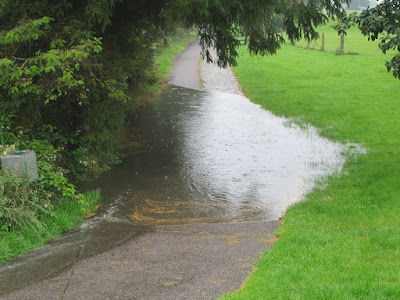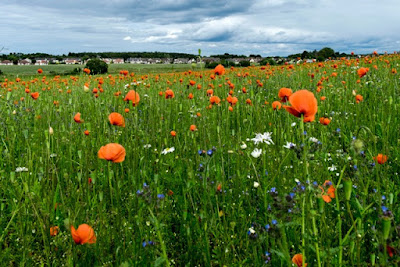Yesterday we published images of yet more spillages at the Merryton/sewage bridge - part of the problem we face with Nairn's sewage infrastructure and contamination that affects the water quality of the river and the beaches.
Anyone in Gurnshire interested in these matters may wish to read the information below that has been forwarded to the Gurn by one of our regular readers. It is the text from a note prepared by Nairn Residents Concern group for the recent stakeholders' meeting and submitted/circulated to SEPA, Scottish Water and the Community Councils and local Highland Councillors. The Gurn understands that this paper has been accepted as an agreed framework for future action by the major players in the working group set up to deal with the recent bathing water quality crisis.
Keep yourself informed folks and ask questions of your local representatives - especially the Highland Council ones, you may see a bit more of them between now and the local elections in May. Now for a wee read, have that cuppa or pour that dram...
1.
Tourism. Beach-related tourism is vital to
the town – indeed defines its image and reputation. Seaside recreations, including bathing,
sailing and other watersports, and a high-quality natural environment are key
elements in Nairn's appeal to visitors.
The classification of the water quality at Nairn's Central and East
beaches as “poor” (and the considerable publicity and reporting of this) has
done immediate and significant damage to the town as a recreational
destination. A brand image, once
tarnished, takes a very long time to recover. The PR challenge is not so much
to disseminate information, rather it is damage-limitation. Re-establishing credibility (especially in
view of the apparent disconnect between SEPA classification, Blue Flag awards,
and Trip Advisor ratings….) is an important task.
2.
Local
economy. It follows
that tourism is one of the principal drivers of the local economy. The retail
sector, the hotel & B&B operators, the caravan park, and other service
and amenity providers all rely heavily on the (seasonal) flow of visitors. Any deterioration or questionmark over the
quality of the natural environment – especially the beaches, riverside and the
water of the Moray Firth - risks leading
to a decline in visitor numbers. This
directly threatens seasonal employment and potentially the viability of local
enterprises (many of them small businesses) already affected by wider economic
pressures.
3.
Health. The implications for the health of
residents and visitors alike of contaminated bathing water, especially by e.coli,
i.enterococci and other sewage-related organisms, are too obvious to
need spelling out.
4.
Future
development. The
longer-term prospects for the expansion of Nairn, the delivery of more housing,
and the promotion of business investment all depend on the adequacy, capacity
and effectiveness of the infrastructure – drainage and sewage just as much as
water supply, roads, telecommunications and other services. Limited capacity or shortcomings in the
drainage and sewage networks and plant become constraints on development (as has already been signalled by the recent
SW policy requirement that all the costs of future drainage/sewage provision
will have to be met, upfront, by developers).
What needs to be done?
(the key objectives)
1.
The
current debate was triggered primarily by the public reporting of the
implementation of a 2006 EU Directive requiring by 2015 the classification –
and posting of public warning signs about – bathing water quality…… which in
the case of Nairn beaches is defined as “poor”.
2.
Meetings
in recent weeks/months have focused on the detail of the wording on signs and
interpretation of the sampling statistics which determine the
classification. This is one of the
requirements stipulated in the Directive.
But it does nothing to tackle the risks, or causes, of the
contamination.
3.
The
key requirement is rapid action to mitigate, alleviate and prevent unacceptably
high levels of contamination in the River Nairn, its outflow into the Firth,
and the adjacent beaches.
What is currently proposed? (the
draft improvement plans)
9. The draft plans (circulated for the meeting) are
described as 'work in progress'. In summary, they identify four strands of
SEPA/SW activity undertaken or under way:
•
modelling
(review of SW map of output), with more modelling as a potential future action;
•
sampling
(modification/variation in sampling frequency and locations);
•
talking
(the convening of a stakeholder group);
•
signage
(review of texts, design, and wording of signs).
1.
Given
the clearly identifiable objective noted at para 8 above, this is wholly
inadequate and misses the point. None of the proposed actions represent
specific practical measures on the ground to reduce pollution-risk or bacteria
levels. None of the proposals in the
drafts are remedial action.
2.
The
draft plans address the symptoms, not the cause(s). Sampling variations (and “discounting”) are
simply ways to manipulate statistical data.
Modelling is hypothetical and only as good as the underlying assumptions
(and has already been shown to have been inadequate as a predictive tool). Signage has no effect on the levels of
pollution: its principal effect –
however much explanation is provided and whatever text is used – is to
deter. Discussion meetings have value,
but only insofar as they enable a two-way dialogue and lead to decisions and
outcomes: meetings are a means to an end, not an end in themselves.
What needs to be tackled? (the issues that should be addressed)
12. The following checklist is not in any order
of priority or achievability. It
identifies a number of issues which an action plan or improvement plan ought
sensibly to address, and which merit discussion by stakeholders on the basis of
relevant information. Some call for
short-term measures. Others may be long-term aspirations. Few are unique to Nairn. But all have a bearing on the task of
improving local bathing water quality.
i. High
Rainfall and Combined Sewer Outflows (CSOs). Much of the evidence so far
confirms that high bacteria counts correlate with periods of high
rainfall. It is also a fact that much of
Nairn relies on CSOs. As the WHO
guidance explains:
Combined
sewer and stormwater overflows, which are built into most sewerage systems
where the effluent “combines” with rainfall, may present the greater health
risk, because water users may be exposed to diluted untreated sewage. Where the
sewer does not receive surface water after rainfall, the “uncombined”raw sewage
overflows present a direct health risk, contact with which should be avoided.
The
best option is
to have separate
collection systems for
sewage and rain/stormwater.
Although treatment is an option for combined sewer overflows often the
treatment plant cannot cope with the quantity of the sewage, or the
effectiveness of the treatment is lowered due to a change in the “quality” of
the sewage.
Replacing the existing system with
separate systems is clearly a very ambitious, costly and long term aim. But
recognition of the shortcomings of CSOs, and action to minimise overflows, has
to be a part of an improvement plan.
ii. Human waste v other pollutants. Much recent
discussion and official comment has pointed to agriculture and ruminant waste
as a source of pollution, particularly in the upstream catchment area. This may
be a factor. But SEPA's own bathing
water profiles for Nairn's beaches refer to DNA testing and conclude explicitly
that “mainly human sources are likely to be contributing to affect bathing
water quality” . That being so, it
makes no sense to prioritise resources and effort on the agricultural
dimension. Given that Nairn is at the
mouth of the river with an urban population of some 10,000 while the hinterland
(catchment area) is sparsely populated with declining numbers of livestock, it
is self-evident that action has to be concentrated on the principal (ie human)
sources of faecal pollution. This
means an improvement plan should prioritise action to mitigate risk in the
location(s) where the greatest problems of wastewater and sewage-management
arise.
iii. Condition of ageing
network. The network especially in the older parts of Nairn, is old – much
dating from the Victorian era. Like
bridges, the pipes are no longer fit to carry the increased loads placed on
them. Like bridges, they are prone to
collapse. This is a nationwide problem.
Large-scale replacement (with or without separation) is a long-term goal, and
costly. But there is no alternative to the progressive, gradual
replacement of ageing pipes, and an improvement plan should outline a strategy
and indicative costs for this.
Meanwhile the operational problems of silting up, blockages, cracks and
collapses underline the crucial importance of regular, consistent surveillance
and maintenance, and joined-up action with the local authority (eg over surface
runoff, roadside drain-clearing etc) to ensure that the old network is kept as
robust and capable as possible.
An improvement plan should spell out the operational
maintenance obligations and targets.
iv. Capacity of the network. It has been officially
recognised that the Nairn network is already under stress. This has implications for planning for future
construction development and for the expansion of the town. It follows on from the age and condition
problem: for example, older pipes are
generally smaller, and routes and access points have been modified (or blocked
up) over the years. An improvement
plan ought to include proposals for the expansion of drainage/sewage network
capacity with indications of cost and funding sources (eg developer-funded).
v. Effectiveness
of WWTW. There seems no major concern over the plant's designated
capacity. Recent issues have been
technical failures/malfunctions (the 2014 'abnormal event') and the problems of
odour. These have reportedly been
addressed, which is encouraging. But
there is a persistent concern that the WWTW is not always operating at optimum
efficiency. It would be useful to see in the improvement plan some
indication of the level of reliability of the plant.
vi. Direct
discharges at peak times. It is
recognised that in certain “emergency” (?) circumstances raw or partially
treated sewage is discharged, or overflows, directly into the River Nairn. This is regulated by SEPA through
consents/licences. Ideally there should
be enough marginal capacity in the system for this never to occur. The
frequency, and “acceptable threshold” of authorised discharges, is not widely
known. An improvement plan should
look at what alternatives there might be to licensed discharges; and what scope there might be to raise the
threshold either temporarily (to allow bathing water recovery - a “blitz”
measure?) or as a specific and measurable objective to be attained
progressively over a period of time.
vii. Unmonitored/authorised discharges. Two
particular aspects. The improvement plan
should spell out the management and monitoring regime for septic tanks
(both urban and rural), the number of which appears not to be known. The other problem, specific to the town, is
the discharges of chemical toilets and associated waste from campervans, either
into the river or into drains. This
threatens the WWTW processes. It is
seriously polluting. It is illegal. Since campervans are an inevitable part of
the tourism sector and will continue to visit the town, a strategy is required
(largely involving the local authority, not the utility companies) to deter the
practice, and also to devise acceptable alternative disposal provision (whether
public or 'commercial'). Prosecution may be a costly last resort, and it
appears sensible for an improvement plan to indicate possible alternative
options.
viii. Flooding – especially of
Fishertown. The Highland Council is committed to delivering a flood
management plan, although the timescale/priority appears to have slipped. The flood risk in certain areas of Nairn has
been designated as severe. The configuration of the local CSO network means
that flooding is of sewage as well as rain or grey water, so the linkage is
obvious. Flood management is a national
and regional priority. The debate over
the implications of climate change has reinforced the case for
“future-proofing”. It is noteworthy that
flood alleviation works have already been delivered in Inverness (the Ness), in
Forres (the Mosset) and in Elgin (the Lossie) at a cost of many millions. All have similar catchment area
characteristics, All have comparable
levels of risk. This raises the
question – which an improvement plan should address, and stakeholders should
have the opportunity to discuss – of the
rationale for the absence so far of similar works in Nairn and the case for
assigning such work a higher priority.
Final comments
1.
The
problems are physical (sewage and waste overflows, bacteria in the
water) and presentational (how best to advise and explain water quality
within the rules and without detriment to the tourism message). Dealing with them requires sustained effort
and attention and a joined-up collaborative approach, accompanied by clear,
factual explanations.
2.
The
solutions require technical expertise (from the agencies), financial resources
(from national and regional authorities), and political will. The stakeholder group can, and should, have a
role in influencing the priorities for action, exerting pressure for the
allocation of resources, and monitoring the process of delivering the necessary
improvements.




 THANK YOU
THANK YOU






















